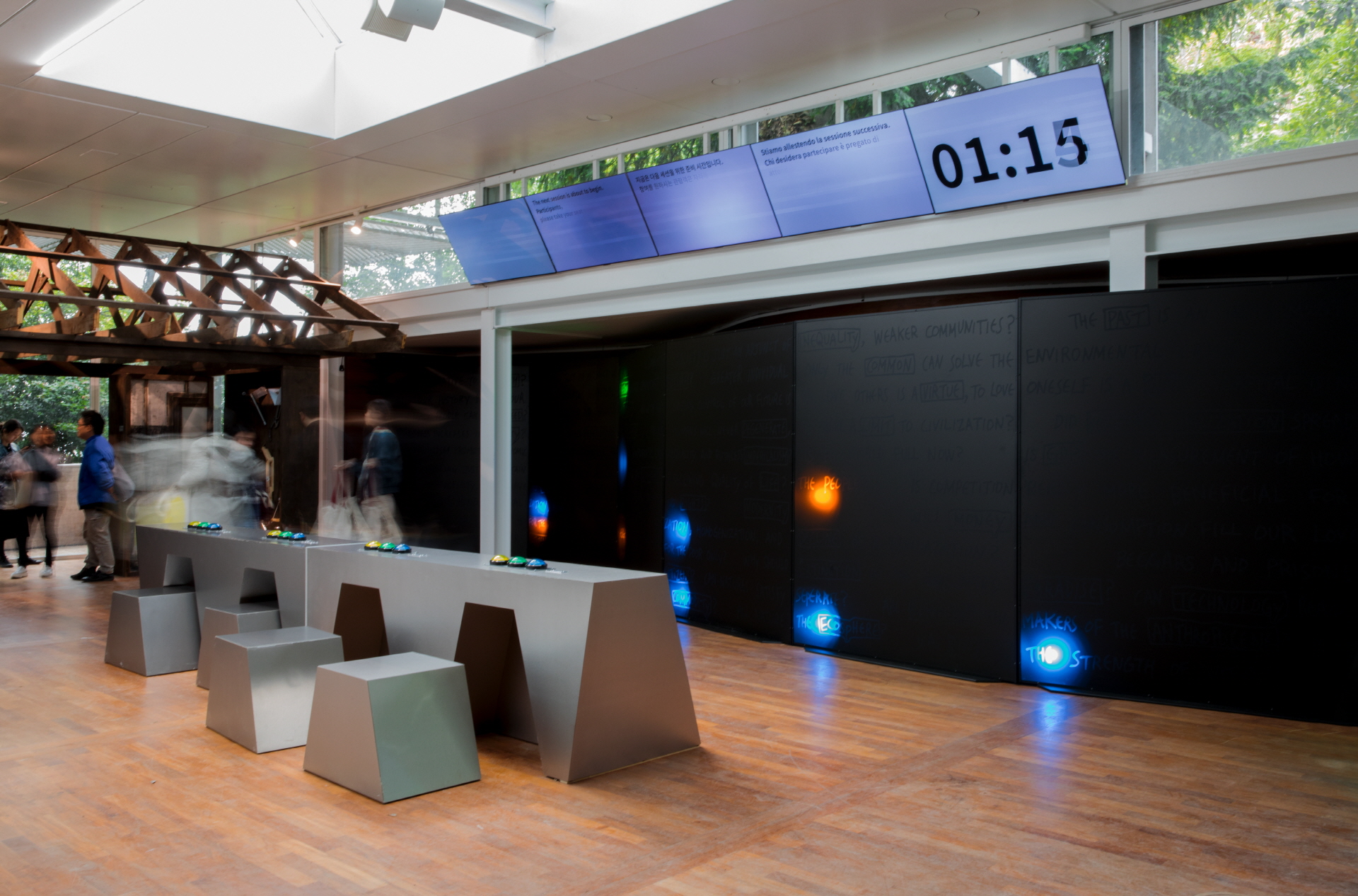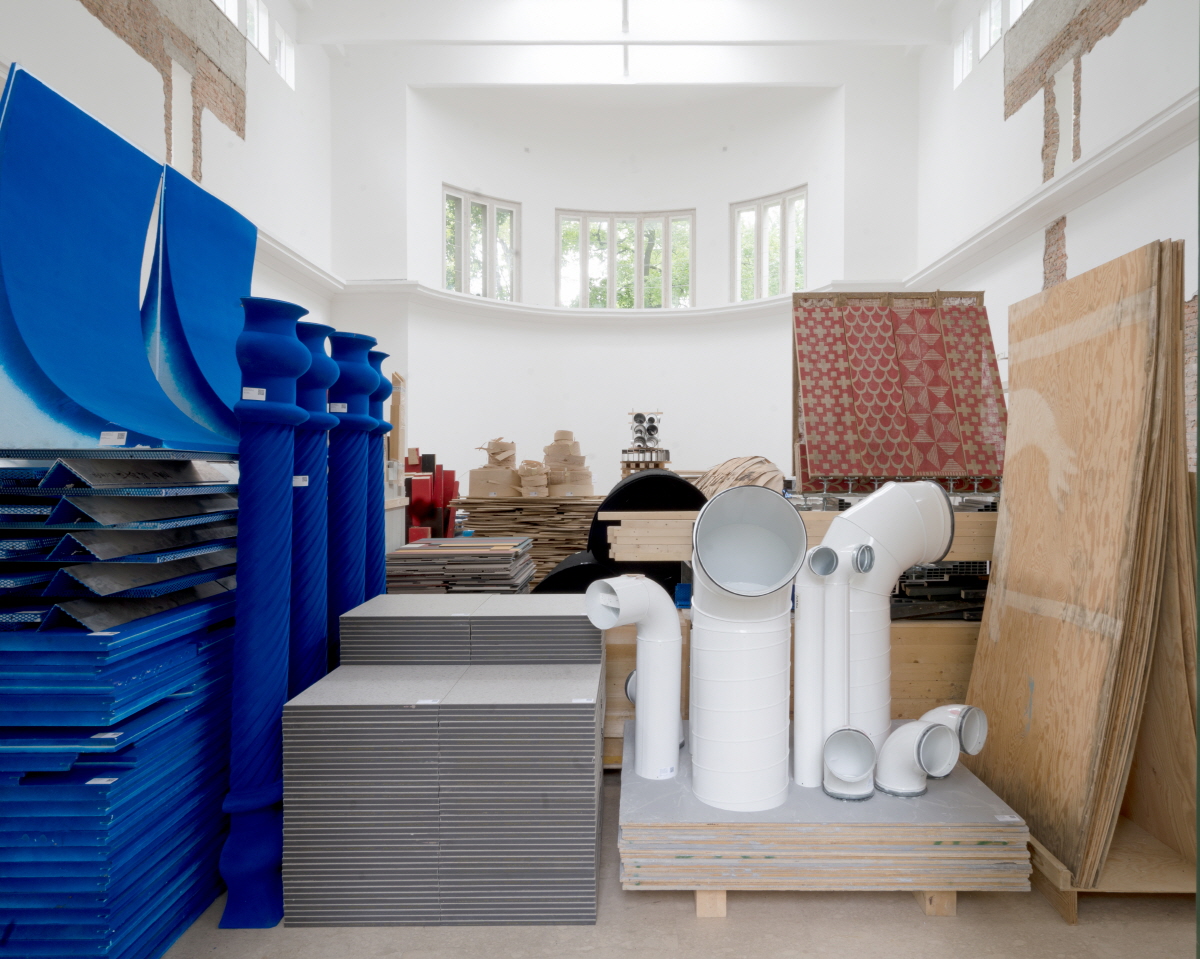SPACE August 2023 (No. 669)
The 2023 Venice Biennale opened on the 20th of May. Under the theme of ‘The Laboratory of the Future’, a total of 63 national pavilions participated in the Biennale, presenting their experiments to explore the future in the era of the climate crisis. Kim Kwangsoo (principal, studio_K_works), who visited Venice after being asked by the Arts Council Korea to review the Korean Pavilion and the national pavilions, said, ‘I had a feeling of futility and scepticism about the culture of various biennials, but I wanted to visit the site after a long time because it is not what I saw and felt in the field. And it turned out to be a good experience.’ We want to borrow his perspective to give an overall sketch of the Korean Pavilion, some national pavilions, and the themed exhibition.
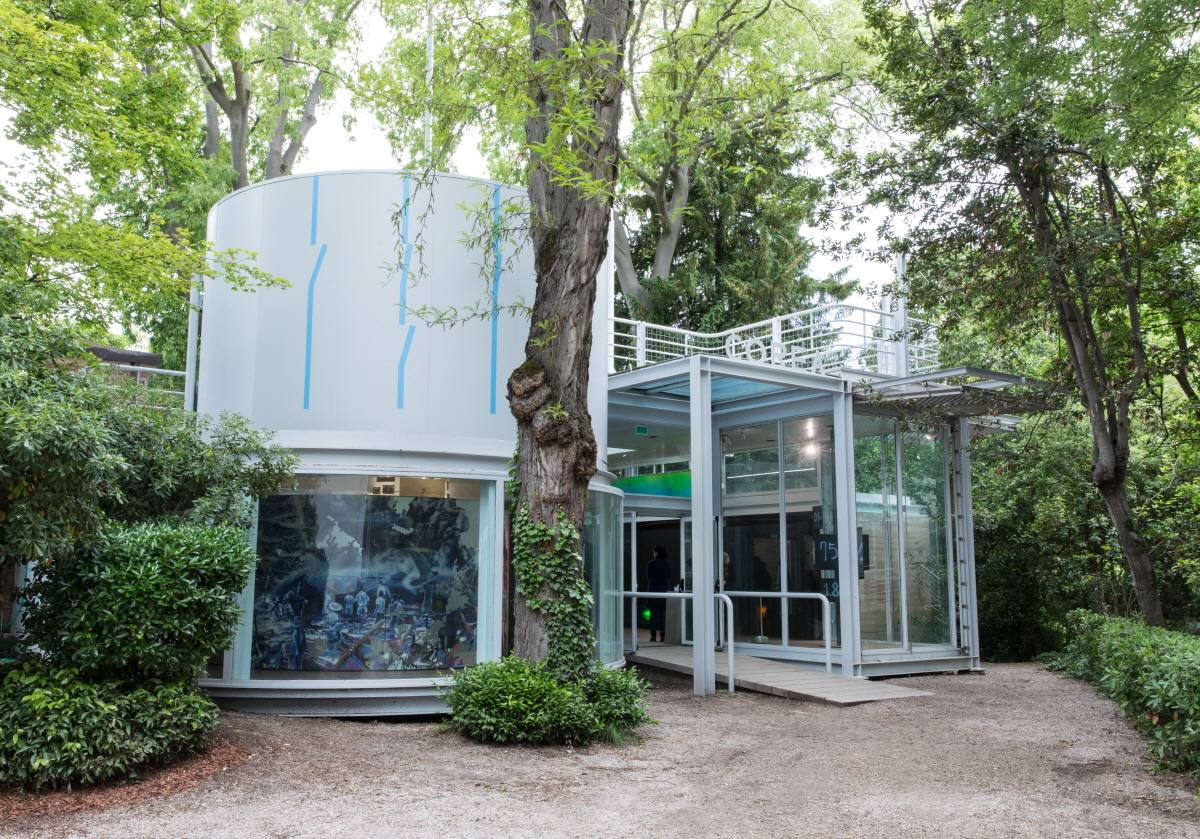 View of Korean Pavilion Image courtesy of Art Council Korea / ©Agne Raceviciute
View of Korean Pavilion Image courtesy of Art Council Korea / ©Agne Raceviciute
The Korean Pavilion
The Korean Pavilion’s exhibition, titled ‘2086: Together How?’, is a critical reflection on the current state of urbanisation, which stems from industrial society and the situation of various local and peripheral communities in Korea. It also examines the relationship between the local and the global, the settled and the unsettled, and migration amidst a sense of anxiety and crisis resulting from environmental and political-economic issues worldwide. It is set in the future, in 2086, when the world’s population will peak, and asks what will result from our choices today.
In the exhibition, a game project and three site-specific projects represent this approach, which questions the global environmental crisis. The site-specific works focus on small communities on the periphery of large cities or within provincial towns, including the Baedari community in East Incheon, a small community in the old downtown of Gunsan, and a migrant worker community in Ansan. The game project is a collaboration between co-directors Jung Soik (principal, Urban Mediation Project) and Park Kyong (professor, University of San Diego) and installation designer OUR LABOUR, while the local work is a collaboration with local activists, artists, and architects in discussion with the two co-directors. The ways in which each work operates within the gallery and the resulting outcomes vary.
The East Incheon Baedari team, led by Suh Yehre (principal, Urban Terrains Lab) and Min Woongi (principal, Space Beam), interprets a local community’s struggle over the past 15 years for a sense of belonging and ecological integrity that was threatened with disintegration by planned highway construction. It is as if a warning light has been switched on, looking at the volume and speed of urbanisation in the name of growth and progress through the eyes of ruins and compost heaps. However, rather than putting an end to the ruins or the growing compost pile, we can see that they, along with the agents involved, hope the residual matter will ferment and become meaningful. Looking at the exhibition catalogue of the Korean Pavilion, it seemed to me that it moved from Walter Benjamin’s theory of ruin to Greimas semiotics of contradictory relations, which is neither raw nor cooked but fermented, and contained seeds of hope in the current mess. Isozaki Arata’s theory of ruins is also mentioned in the book, and I was reminded of his contemporary Sakaguchi Ango’s writing Discourse on Decadence in post-war Japan.
The participating artists depict a series of situations in allegorical or dystopian drawings accompanied by archival images,and the works seem to be a mix of post- apocalyptic despair and hope. However, the excruciating siteness, the physicality of the struggle, and the materiality of the decay or ruins are reduced to two-dimensional images. Despite the meaningful perspective of Baedari team’s work, transferring the realities of the East Incheon area to a distant and crowded exhibition space was not easy, and it was questionable whether the contemporary media environment or the audience’s situation would allow such a mode of transmission. The difficulty of delivery itself must have been a concern for the Baedari community in the past. In the reality of an advanced civilisation where the experience of rawness, far from fermentation, is disappearing, the point at which the medium does not allow it, or the point at which transmission or reproduction is annihilated, becomes more critical, and I felt that they could not help but think about it as an artist because it is already a pressing topic and dilemma.
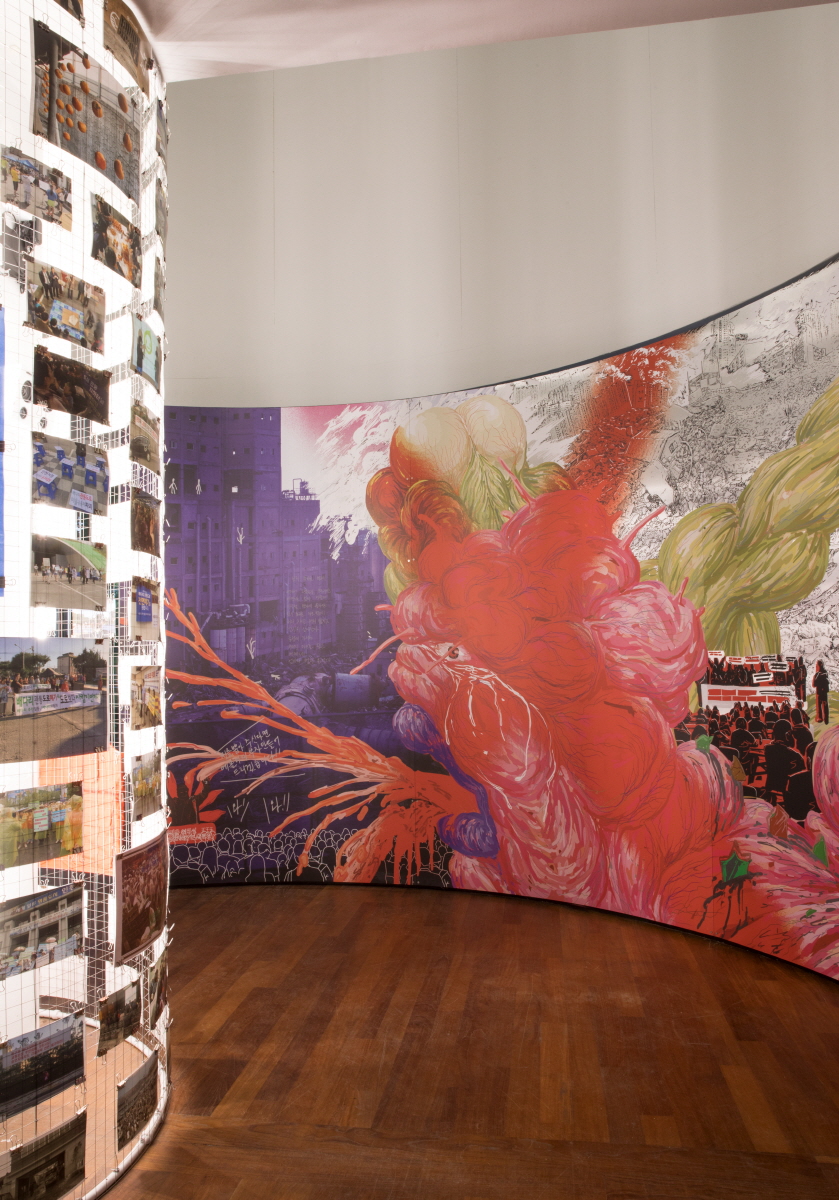 Views of ‘Ruin as Future, Future as Ruin’ section by Suh Yehre and Min Woongi Image courtesy of Art Council Korea / ©Agne Raceviciut
Views of ‘Ruin as Future, Future as Ruin’ section by Suh Yehre and Min Woongi Image courtesy of Art Council Korea / ©Agne Raceviciut
The Gunsan team, led by Studio UDTT (co-principals, Yoon Zoosun, Chae Ahram), Yerin Kang (professor, Seoul National University), and Lee Chihoon (co-principal, SoA), worked on the premise of movement and migration rather than on an adherence to place, given the decline of Gunsan’s old downtown and the emergence of countless empty houses. In contrast to the traditional attitude of insistence on the land and the view of construction as a means of emptying out rather than holding on, the dismantling of empty houses and the infiltration, restoration, or re-naturalisation of nature, which constitutes the basis of human existence centred on place or home, presents a work premised on mobility. The exhibition shows an approach that attaches existential meaning to the tools used to dismantle the empty houses. The roof structure of an empty house that was actually dismantled in Gunsan is brought to the exhibition and reassembled, and the tools and instruments that the artist designed and manufactured for the dismantling are also on display. Furthermore, the process is filmed and shown at low speed on a monitor inside the roof structure so that the intention and process of the work are conveyed within the exhibition space, and the roof structure and tools can be directly sensed.
In addition, by carrying out the project with an alternative local community that had moved to Gunsan from outside the city, they seemed to see loose solidarity and possibility not limited to the geography of the outsider or people experiencing homelessness. Solidarity is an assemblage between human and non-human agents (grass, trees, soil, tools, etc.), as Bruno Latour articulates, and it was a fitting composition as Giardini’s lush grass and trees were visible through the glass wall behind the installation of roof structures and tools. Overall, the work’s sequence, context, and content felt seamless, and the installations all seemed to fall into place. But at the same time, it was also refreshing to feel a sense of stability and security in a world where disagreement is the norm and indeed the hallmark of the era. It was difficult to discern whether the outcome resulted from wandering or pedesis, an ongoing process of encountering chance (creation for destruction) or a planned objective (destruction for creation). This is because, alongside coherence and order, the latent realm of incoherence and disorder is the larger realm of human and non-human principal agents collectively known as nature. Nevertheless, the Gunsan team responded intelligently to today’s predicament with the theme and practice of destruction and creation, and their ideas were clearly presented.
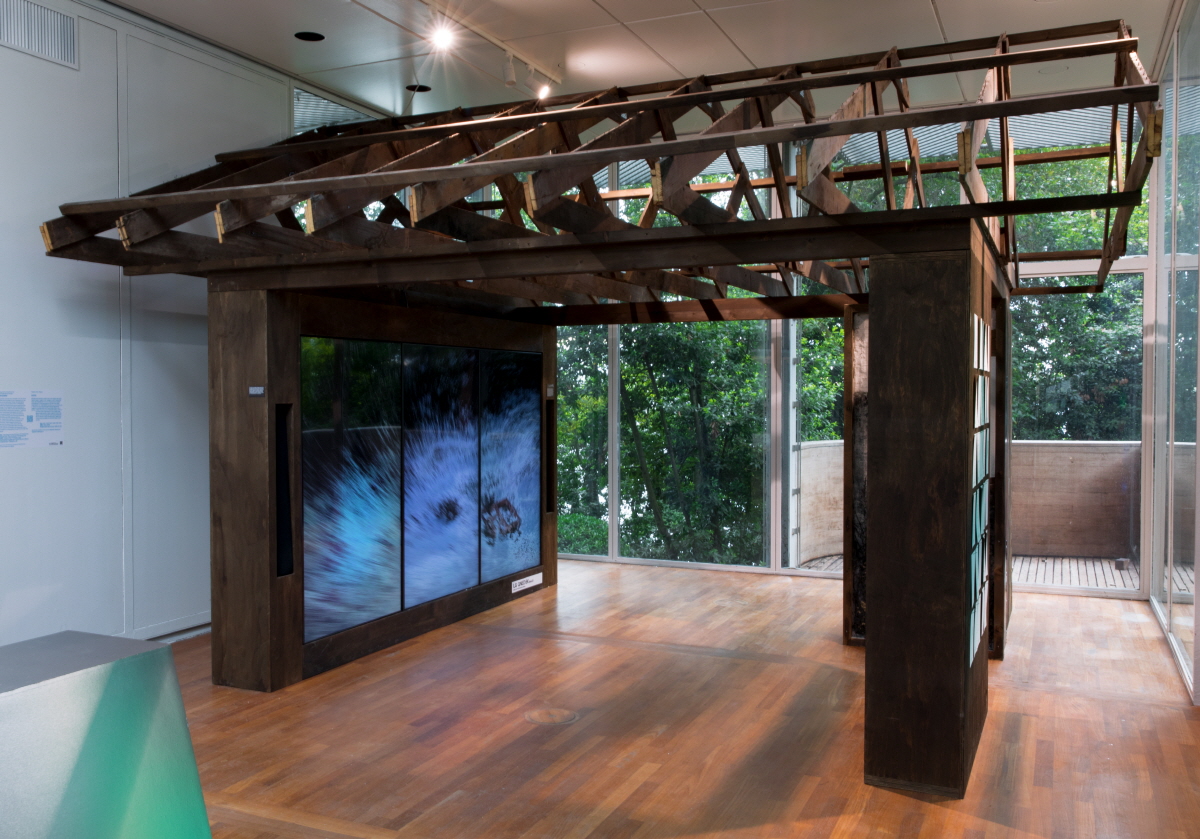 Image courtesy of Art Council Korea / ©Agne Raceviciut
Image courtesy of Art Council Korea / ©Agne Raceviciut
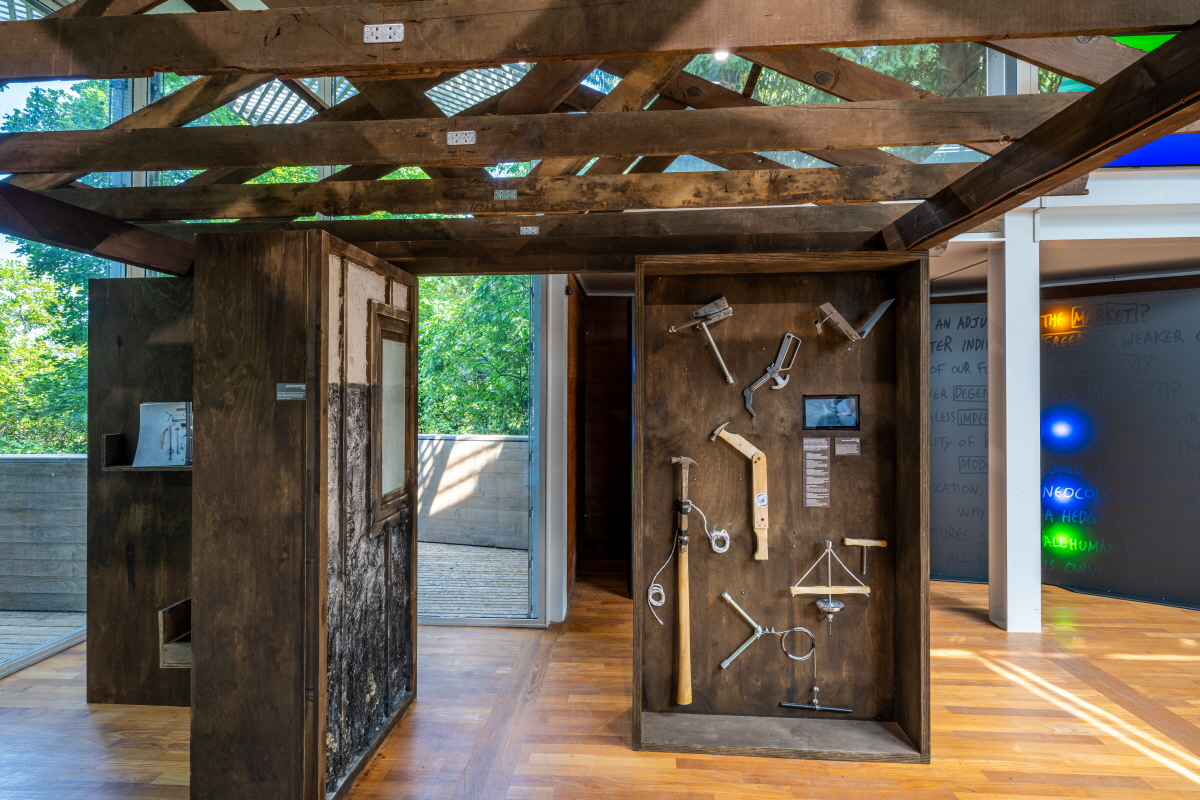 Views of ‘Destructive Creation’ section by Studio UDTT, Kang Yerin, Lee Chihoon Image courtesy of Art Council Korea / ©Daniele Nalesso
Views of ‘Destructive Creation’ section by Studio UDTT, Kang Yerin, Lee Chihoon Image courtesy of Art Council Korea / ©Daniele Nalesso
The Ansan team of Kim Wolsik and N H D M (co-principals, Nahyun Hwang, David Eugin Moon) takes the form of an architect and an artist exhibiting their respective works through an understanding and survey of the hybrid culture that includes not only the citizens of Ansan but also various migrant worker communities and shamanism. Beginning with an understanding of the city of Ansan, N H D M exhibited a collage of 2D images that dealt with the ever- present issues of settlement and non- settlement, growing hybridity, tension, and the mobility of the diaspora, as well as a drawing of a migrant worker’s living conditions titled Home is not a (Vinyl) house. Kim focused on migrant workers because he perceived a sensory anomaly or peculiarity (witchcraft) in modern people. In other words, it deals with a return to a new or reconstituted shamanic culture that is shaped with the bodily responses of migrant workers who have moved to different climatic zones, along with a sense of a general shift in contemporary situations towards a common sense of shamanism— this can be seen in the artist’s observations. The artist exhibited an intriguing digitally created ASCII drawing called ‘Shaman’, a small composition of foldable mobile greenhouses and big carriers within them, and a video called A Child Eating Sunlight, which seemed to respond to the physicality of climate and environmental change during the pandemic. It seemed to herald a new species of human born in the climate crisis context. The catalogue texts in this section read like a poem about a distant past and today’s reality; the works were a fascinating extension of that.
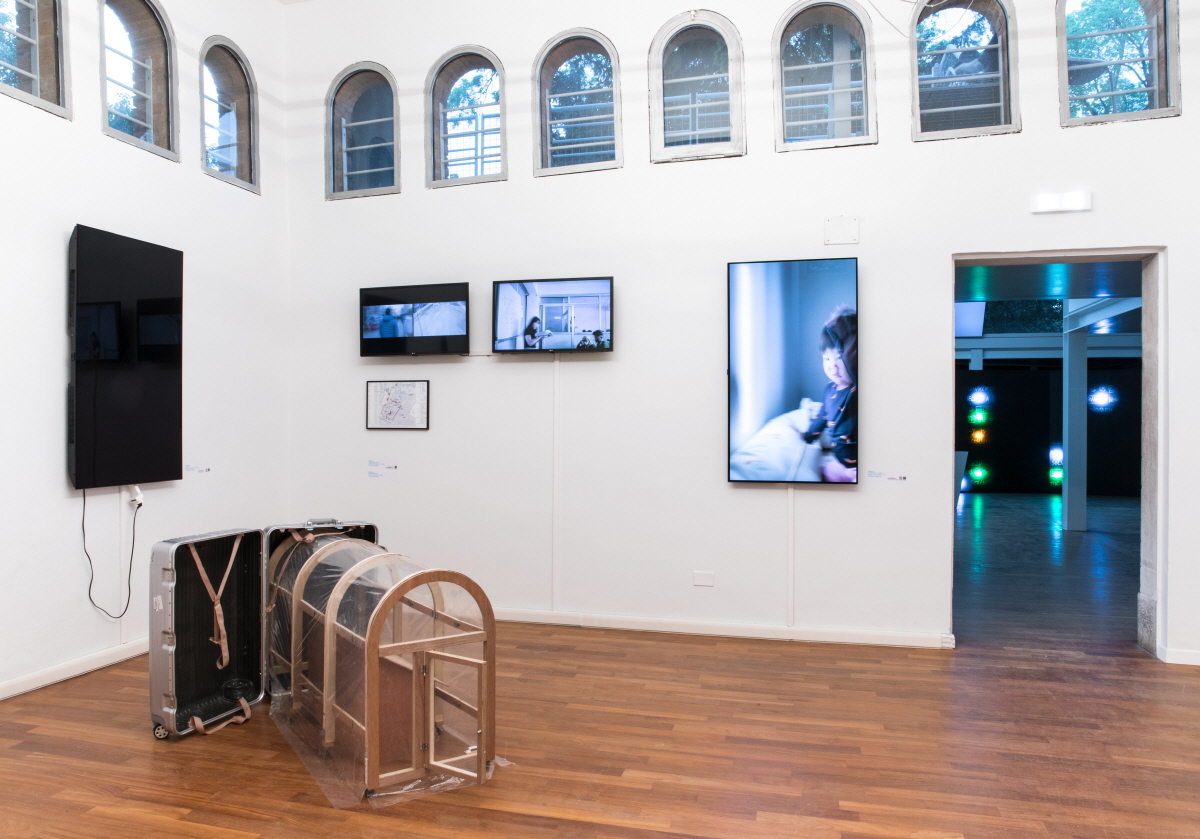 View of ‘A Community of Difference’ section by Kim Wolsik Image courtesy of Art Council Korea / ©Agne Raceviciut
View of ‘A Community of Difference’ section by Kim Wolsik Image courtesy of Art Council Korea / ©Agne Raceviciut
Visual artist Jung Jaekyung’s film A Future, which encompasses the realities of the three regions of East Incheon, Gunsan, and Ansan, is screened on separate wall monitors in the three exhibition areas. The work is a scenario for the future, organising the growing sense of crisis and anxiety through the conspiratorial form of a state secret report. The artist interacts with an unidentified young child with precognitive abilities (the child is born without the divided sensory functions of the five senses and without the ability to speak, having only a caterpillar-like body and a sense of touch). The artist depicts a situation where truth is difficult to discern, where it is not known whether the child is a saviour or a destroyer. Clairvoyant images are shown floating around the world, as transmitted by an artificial intelligence connected to the child’s neural network. These clairvoyant images are presented in very poor, low- resolution images to evoke a sense of reality, addressing the widespread distrust of top-down authenticity judgements from the superstructure of society, as well as the prevailing sense of an age that embraces conspiracy theories, shamans, and seers. The tension between the public and the state apparatus is fascinating, especially when read in conjunction with the classified reports in the catalogue.
The game project, which occupied a large part of the central area of the exhibition and was conceived by the two co-directors and created by the installation designer, begins with a series of three- point multiple-choice questions posed by various subjects, including fictional multinational organisations, social groups, alliances, professors, advisors and security companies, appearing on a 12 × 2m scoreboard. As the viewer presses buttons in a somewhat retro colour scheme of red, blue, and yellow, the information from the selected answers accumulates until the end of the biennale (which is set for 2086, when the world’s population will peak in proportion to the duration of the exhibition). The intention is to report on what the future might look like due to these choices and accumulations. At the pre-opening, audience engagement was relatively steady. However, the level of participation and cumulative statistics during the long exhibition period remains to be seen, and the gradual change of the scoreboard is also questioned.
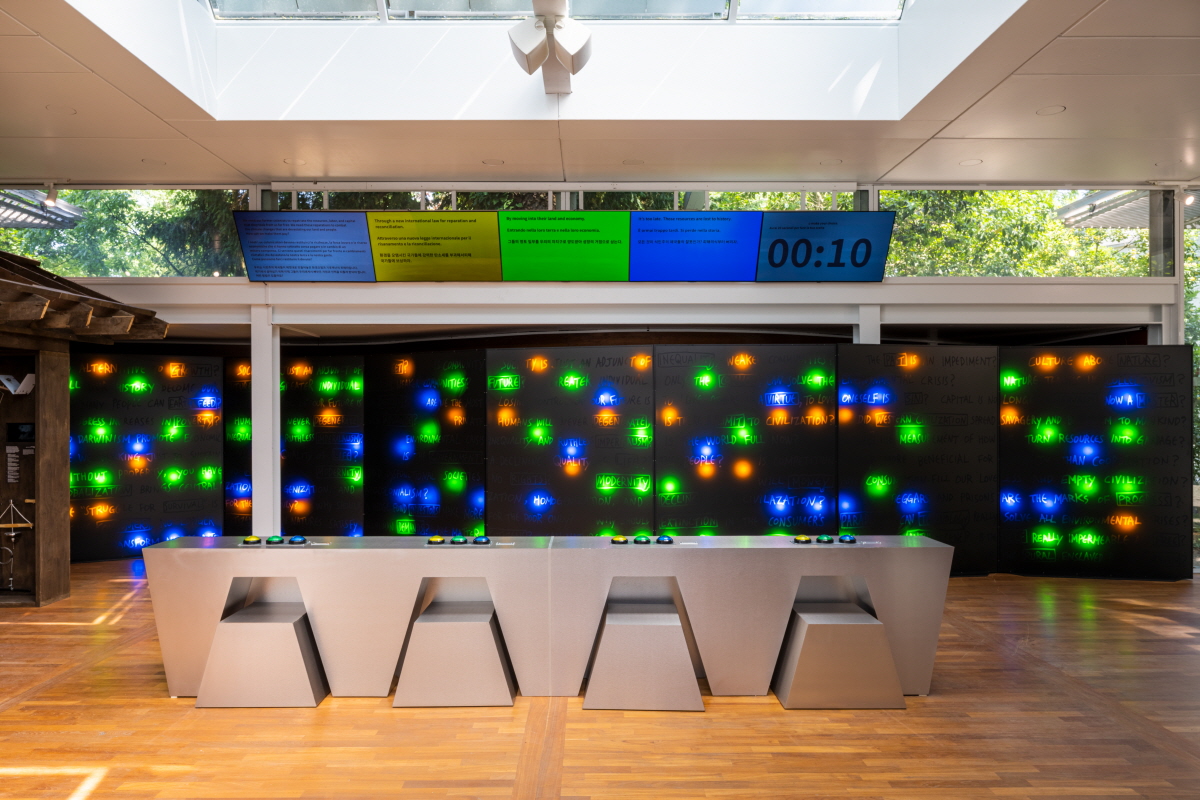 View of ‘The Game of Together How’ section Image courtesy of Art Council Korea ⓒDaniele Nalesso
View of ‘The Game of Together How’ section Image courtesy of Art Council Korea ⓒDaniele Nalesso
The works listed so far take quite different approaches, but they all have narratives that ultimately require each other. On reflection, we can read a relationship between ruins or decay, fermentation, an alien agent (migration) like the yeast needed for fermentation, and the birth of a new species. Of course, this is not a continuous narrative but a disjointed arrangement that, upon reflection, leaves an afterimage, like image dialectics. In other words, it is not the narrative connection between individual images but the space between them that is the realm of experience and which leaves an afterimage.
Park Kyong said that all future narratives in today’s unpredictable world end up being fictions and don’t provide any credibility or direction, so they leaned towards restoring cosmology through mythology rather than fiction. This is because myth is a narrative structure with many digressions, growth and evolution, tradition and transmission. The Korean Pavilion seems to have been a laboratory for this recovery.
In the exhibition catalogue for the Korean Pavilion, a chapter titled ‘Tomorrow’s Myths’ appears out of nowhere, taking up a large portion of the front page. The work of the authors of the chapter was not featured in the exhibition, so it seemed irrelevant, and even when I looked at the show and the catalogue together, it wasn’t easy to understand the context at first. It wasn’t until I reflected on the exhibition and read some of the texts that it made sense. On the other hand, the texts in the book, including Tomorrow’s Myths and the texts of the participating artists, are fascinating in themselves, so reading the catalogue is an engaging experience. In particular, the parallels that can be drawn between the Korean and English texts and the formatting and editorial design of the publication make it attractive and accessible. Tomorrow’s Myths is the result of a collaboration with e-flux. It will be presented online on the e-flux website alongside the exhibition.
Overall, the exhibition at the Korean Pavilion was easy to miss if the viewer didn’t make an effort. While there is a great deal of thematic consistency, many exhibit elements created some awkwardness regarding each area’s spatial scale and organisation in the Korean Pavilion. For example, compared to the game project’s simple spatial composition and large black scoreboard, the other smaller-scale areas contained a larger number of elements and components, giving the impression of imbalance. And with most of the exhibits consisting of scoreboards, printed images, or digital drawings and videos, it seemed to lack the tactile sensation of an architectural exhibition or the materiality of a ‘laboratory’, except for the Gunsan team. It was in line with the theme of the Venice Biennale’s organisers, ‘The Laboratory of the Future’, and it was said to be focused on a small area, but as the exhibition covered several regions, the content and scale of the thought experiments were extensive. It would have been challenging to match the structural and spatial scale of the Korean Pavilion. While the content of each section was very meaningful, and the questions posed by each team and their connections were interesting, the exhibition left something to be desired in terms of experience and delivery.
This article continues on to the next page.






